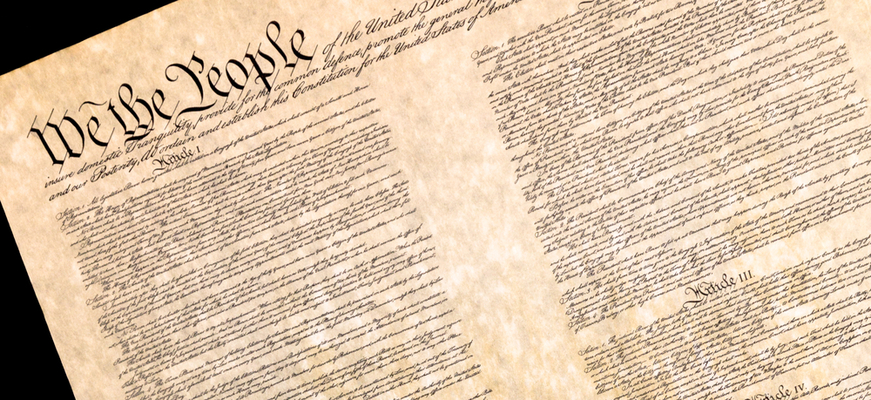In December, Professor Rob Natelson, a former law professor, constitutional scholar, and the world’s foremost Article V expert, uncovered new evidence in support of a Convention of States. Many Article V opponents insist on calling the Convention for proposing amendments a "constitutional convention" or "con-con." But Natelson's latest research confirms that those terms were not used by the Founders but were fabricated in the 20th century.
“A great deal of evidence already has been published showing that a convention for proposing amendments is a convention of the states. In other words, it is a gathering of state delegations, representing their state legislatures in conditions of sovereign equality,” Natelson wrote in an exclusive article for the Article V Information Center. “But now still more evidence has come to light.”
As we head into the legislative season, read an excerpt of Professor Natelson’s research below to equip yourself with the information needed to make an effective case for Convention of States.
“Since the 1960s,” he wrote, “commentators opposed to an amendments convention have been claiming that its nature is a “mystery.” Some even claim Congress can direct the amendments convention process—even though the Constitution’s framers adopted the process precisely as a way to amend the Constitution over the objections of Congress.
In 2020, I published an article with Marquette Law Review (pdf) that collected a large number of documents and court decisions, both from the Founding era and after. They showed indisputably that an amendments convention is a “convention of the states”—a frequently-employed kind of gathering with precedents going back to 1677.
The Founding era information collected in my article included (1) official state convention resolutions, (2) official state legislative resolutions, (3) transcripts of ratifying convention and state legislative debates, (3) various publications, and (4) the first Article V state application ever issued—by Virginia in 1788. All referred to a convention for proposing amendments as a “convention of states” or, occasionally, as a “convention of deputies from the several states.”
Natelson went on to explain that since 1976, a group of scholars has been compiling a 40+ volume set on the ratification of the U.S. Constitution and Bill of Rights. In 2022, Natelson obtained a copy which included state legislative records from 1788 (the year the Constitution was adopted). These records contained multiple instances in which an amendments convention was referred to as a “convention of states.”
Below are a few examples:
Virginia Legislative Records
The Virginia state legislative records show that term being used repeatedly even before the Virginia Article V application was adopted. (For those who wish to find the documents themselves, I’m including the page number of the Documentary History’s first Bill of Rights volume):
* On November 11, 1788, a House of Delegates committee preparing the application issued a report referring [to] the… amendments convention as a “convention of the states” (p.167).
* On November 14, 1788, the House passed the application, again using that term (p. 169).
* On the same date, the House considered a draft letter to Governor George Clinton of New York, again using the same phrase. The House also considered a draft letter to the other states using the synonym, “Convention of deputies from the several States” (p.170).
* The final letter to Governor Clinton sent on November 20 also used the phrase “Convention of the States” (p.177). (I did include this letter in my Marquette Law Review article.)
New York Legislative Records
My Marquette article itemized New York legislative records that referred to an amendments convention as either a “convention of the states” or a “convention of deputies from the several States.” However, the new volume of the Documentary History contains even more:
* A December 11, 1788 speech by Governor Clinton to the New York General Assembly referred to an amendments convention as a “General Convention of the States.” (“General” meant that all states or all states from all regions would be invited; it was not to be a regional or “partial” convention) (p. 202).
* In New York Senate proceedings on December 24, 1788, a committee headed by Senator Abraham Yates presented its formal response to the governor’s speech. The report stated, in part, “We are sensible that a revision of the system, by a Convention of the States will be necessary . . . .” (p. 209).
Lastly, Natelson notes that Convention of States opponents “persist in calling it a “constitutional convention.” He counters: “I have found no—repeat no—cases of anyone in the founding generation using that term to refer to an amendments convention—nor, for that matter in the 19th century either. The misnomer “constitutional convention” to refer to an amendments convention apparently did not arise until the 20th century.”
Yet again, Professor Natelson’s research debunks the fears of our critics. Last year, he revealed that anti-convention talking points were invented by prominent establishment liberals with close ties to the D.C. ‘swamp.’” Click here to read that fascinating report.
To join Professor Natelson in his support of our efforts to end federal tyranny, sign the Convention of States petition below.






